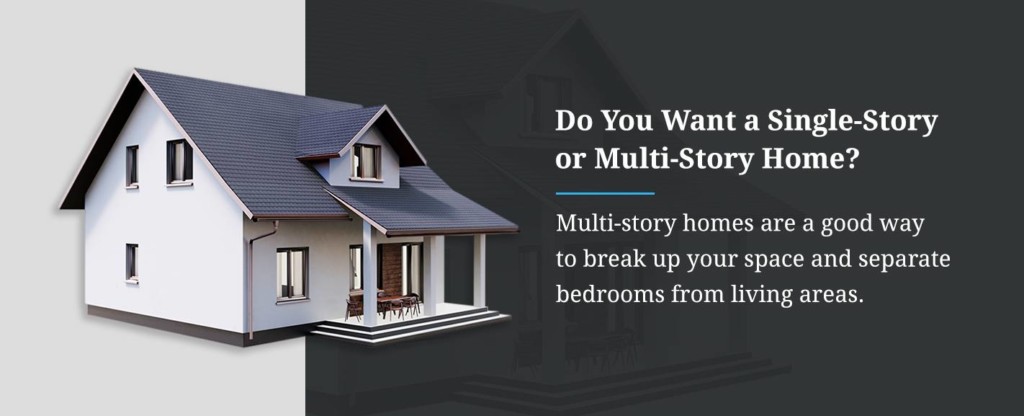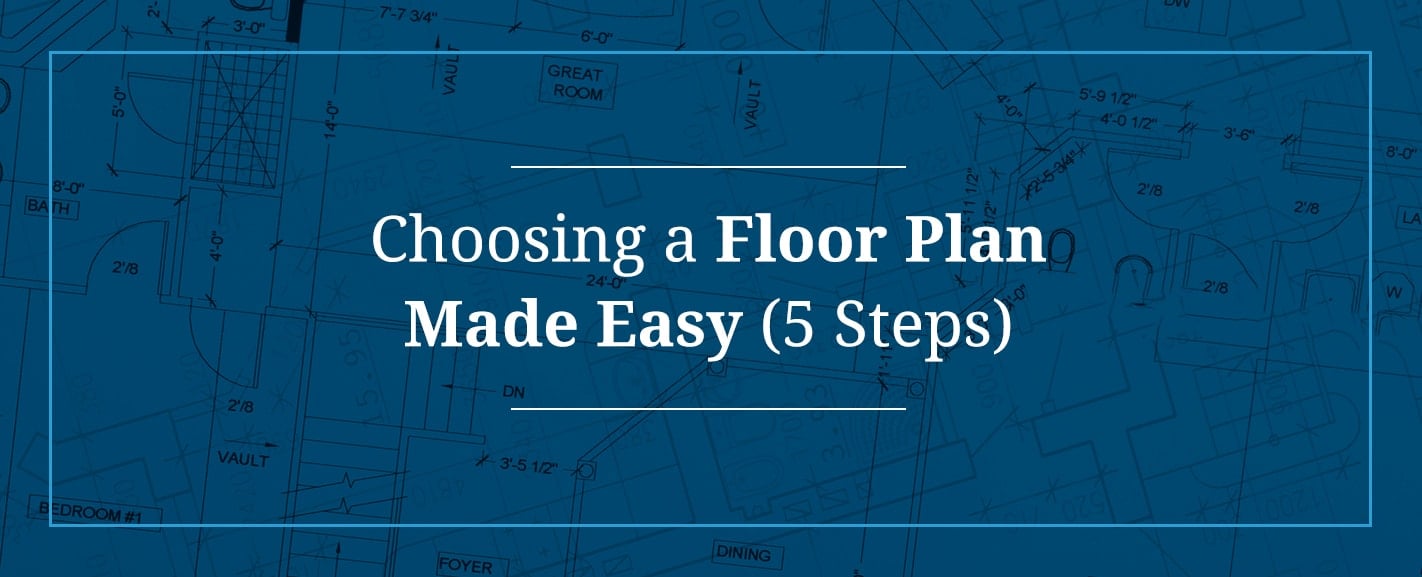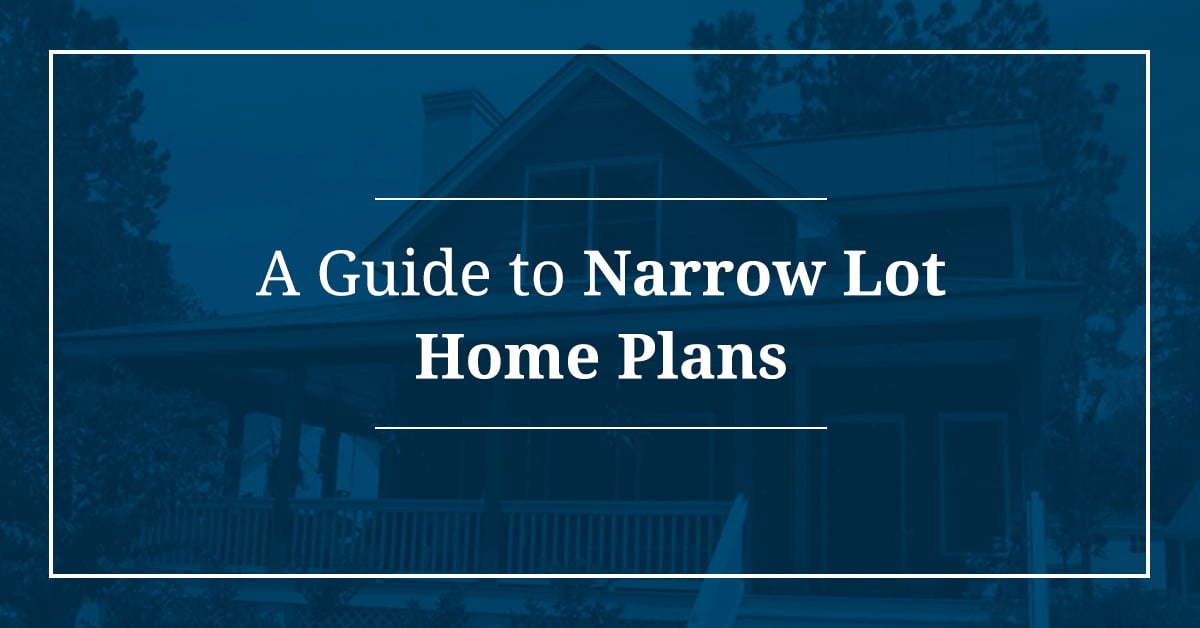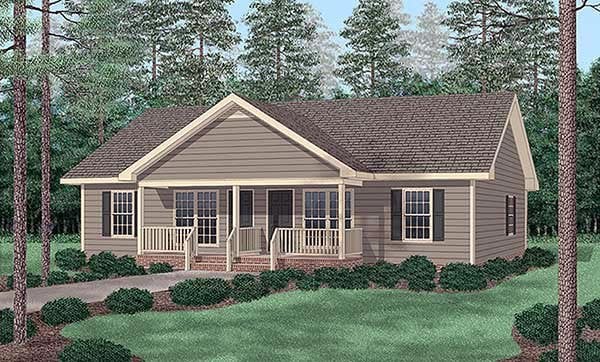Choosing a Floor Plan Made Easy (5 Steps)
If you are beginning the process of building a custom house, one of the first steps is selecting a floor plan. Your floor plan includes the layout and dimensions of your home’s interior and exterior. When it comes to house layout plans, there is an endless number of possibilities.
5 Steps to Choosing Your Home Floor Plans
The average home in the United States is 2,687 square feet. Whether your ideal home is smaller or larger, that is a lot of space to work with. How do you choose the perfect layout? Luckily, there are five simple steps you can follow when choosing your home floor plan.
1. Consider Your Lifestyle
The easiest place to start is by calculating the number of bedrooms and bathrooms your home needs. Although you likely want each member of your family to have their own space, you always want to consider whether or not the house will be too big for you once your children move out. Alternatively, if you plan on having another child in the future, extra bedroom space should be taken into account. You might also need a guest room if you often house visitors.
Look at your everyday routines. Where does your family spend most of its time? Maybe it’s gathered around the television in the living room or cooking large meals in the kitchen.
Do you do any entertaining? If so, a formal dining room or a spacious eat-in kitchen may be nice to have. If your entertaining consists of hosting the annual Superbowl party, plan for a living room with plenty of square footage.
Finally, decide whether an open-concept floor plan fits your needs, or if separate, enclosed rooms are more your family’s style.
2. Do You Want a Single-Story or Multi-Story Home?

Now, it’s time to decide whether you want a single or multi-story house.
Single-story homes are easily accessible for all members of the family. It is also easier to maintain a regular temperature in a single-story home, which saves you money on energy. However, single-story homes often lack the privacy and space that multi-story homes provide.
Multi-story homes are a good way to break up your space and separate bedrooms from living areas. They usually provide more closet storage and privacy from neighbors at ground-level. However, many families do not want to navigate a staircase every day, especially if their household includes small children or older adults.
3. List Features and Amenities You Cannot Live Without
Make a list of all features and amenities you cannot live without. Although not an exhaustive list, some popular home features include:
- Office space
- A fireplace
- Wheelchair accessibility
- Basement or attic storage
- A garage
- A mudroom
- Oversized bathtubs
- Kitchen islands
- Specially designed windows
- A front or back porch
By including your entire family in this process, you can be sure your home will be as functional as possible for all of you.
4. Analyze Lot Characteristics
The lot your house will sit on will determine many of your house layout plans. Familiarize yourself with local zoning regulations that may limit certain features of your home, like height or percentage taken of the total lot. If your neighborhood has an HOA, research their requirements and limitations for custom-built homes.
Consider the shape and terrain of your lot. Is it rocky or overrun with tree roots? This may impact design choices. Which side does the sun face? Is there ample shade? If your lot is especially narrow, you will need to choose an adaptable layout.
Finally, consider the outdoor living space. If your family spends a lot of time outdoors or if you have pets, design your house to leave plenty of yard space left over.
5. Your Budget Is Key
When choosing a floor plan, consider what you can afford to build and maintain.
Begin with an estimate of your total costs, including the cost of your home layout, the contractor fee, building materials, plumbing and electrical hookups, HOA fees or zoning permits, the cost of the lot if applicable and so on. Leave plenty of room for unexpected expenses.
Once you have an estimate of your total costs, create a plan of action. What finances do you have already, and how much do you still need? If taking out a loan, how much is the loan for, and what is your repayment plan? Compare your plan of action to your estimated costs and see how they line up.
Make adjustments as necessary. Building your own home is a complex process. Stay on top of your budget throughout the process and make changes as needed to avoid running out of funds.
Keep in mind how much it will cost to maintain the square footage of your home in the future, including utility bills and general maintenance.
Floor Plan Tips
Now that you have all the information you need to choose a floor plan, there are some tips to follow to ensure a smooth home-building process.
1. Establish a Realistic Timeline
Understandably, you want to move into your new home as soon as possible. After all, you have worked hard creating it! However, all good things take time. Sit down with your contractor and create a realistic timeline and estimated finish date. The average single-family home takes about eight months to complete. However, do not become too attached to this number — many factors, such as inclement weather, can alter your completion date.
2. Keep Energy Efficiency in Mind

Planning your home with energy efficiency in mind can save you a lot of money on utility bills later on. Plus, energy-efficient and eco-friendly homes are better for the environment. Some energy-efficient considerations are:
- The whole-house systems approach: The whole-house systems approach is a method for home planning that takes all energy-impacting factors into account, including local climate, insulation, appliances, water heating and more.
- Ultra-efficient homes: Ultra-efficient homes combine energy-efficient construction with renewable energy systems.
- Advanced house framing: Advanced house framing is a technique for wooden homes, where some of the home’s lumber is replaced with insulation, thus boosting its energy-efficiency and reducing lumber waste.
- Cool roofs: Cool roofs are designed to reflect sunlight and absorb less heat, resulting in a naturally cooler home.
3. Hire a Professional Home Builder
If you have taken the time to choose the perfect layout, make sure you take just as much care choosing your home builder or contractor. Some questions to ask before hiring a home builder are:
- Are you licensed and insured?
- Can I see some of your other projects?
- Are you aware of local building codes?
- Do you offer any warranties?
- How will we communicate?
A professional home builder should not have any trouble answering these questions. It is also a good idea to speak with more than one contractor to make sure you are getting the most value for your budget.
4. Stay on Budget
Remember the budget you created? It is only effective if you can successfully stick to it throughout the building process. Building a home requires a significant level of financial planning. Thankfully, there are a few things you can do to save money while building a house:
- Determine if there are any projects you can take on yourself, such as installing knob fixtures or toilet installation.
- Source your own building materials when possible. This includes using reclaimed building materials.
- Avoid choosing a layout with unnecessary square footage. It is important to have plenty of space in your home to live comfortably, but resist the urge to select a design that offers more space than you will realistically use.
- Understand when to save and when to splurge. Some things, such as second-hand appliances or refurbished furnishings, can save you a lot of money. However, it is okay to splurge on features that will enhance your quality of life, as long as you stay within your budget.
5. Modify Your Layout as Needed
You may need to modify your layout as needed. During the building process, you may find that some elements of your chosen layout do not work well together, given your budget or lot layout. Be prepared for these challenges and plan to compromise if necessary.
Floor Plan Mistakes to Avoid
As you choose a floor plan, know what common floor plan mistakes to avoid.
1. Sacrificing Practicality for Style
Choosing a layout that fits your family’s unique style and tastes is a great way to ensure your home will be enjoyed for years to come. However, be careful not to sacrifice practicality for style. For example, you may prefer the look of floor-to-ceiling windows, but they may not be the greatest option if privacy is important to you. Spiral staircases might be enchanting to look at but could be inconvenient if you’re in a hurry. Walk-in showers are great, but where will you bathe your toddler?
Choose a stylish floor plan that appeals to you, but always keep your family’s everyday routine and needs in mind.
2. Not Considering Window Placement

The two most important factors to keep in mind when placing windows are their exposure to sunlight and the view outside.
Place your windows on the side of the house that allows the most natural sunlight to enter your room. This can keep energy costs low by reducing how often you need to use your overhead lights. The natural light will make your space feel open and inviting.
Consider the view. For example, you probably don’t want your window to be eye-level with the window in your neighbor’s bathroom if you can avoid it. Given a chance, most homeowners would prefer to look out onto a wooded area or backyard than the hustle and bustle of the street.
3. Forgetting to Plan for Furniture
When choosing the dimensions of your rooms, make sure that they are large enough to fit your furniture comfortably. For example, measure your sofa’s length and be sure that you can fit it into your living room. The same goes for large bedframes or dining room tables.
4. Neglecting Storage Space
The average American home houses 300,000 items. When you factor in holiday decorations, sentimental items and accessories your child has outgrown, this number makes sense. Be sure to design a space with enough storage to accommodate it all. This may include closets, attic or basement storage.
5. Designing for Your “Ideal Life”
While choosing a layout, you begin to imagine what your life will look like in your new home. You may choose a large formal dining room to host all your dinner parties or an enormous chef’s kitchen to test out all your recipes. But do you do those things? Make sure you are planning a house that suits your realistic living situation, rather than an idealized version of your life. If you don’t host many guests or eat takeout most nights of the week, apply that part of your budget toward a different part of your home that you use more frequently.
6. Ignoring Your Neighborhood
Take a walk in your new neighborhood and note the homes you see along the way. Decide whether you want your home to stick out or blend in with its surroundings. For example, a modern glasshouse would be very noticeable in a neighborhood full of Cape Cod-style homes, as would a log cabin in a community of upscale, urban developments.
Find Floor Plan Samples for Every Style
With so many options, finding a new house plan for your family can be overwhelming. That is why Family Home Plans categorizes our plans by architectural style, best sellers, and more. A house plan database — like Family Home Plans — can help you find floor plan samples for every style. Some popular housing design choices include:
You can also browse Family Home Plans by collection. This allows you to search for home plans by specific features. Some collections are:
- Camps, cabins and cottages
- House plans with hobby rooms or workshops
- Home plans with a mudroom
- Narrow lot house plans
- House plans with sunrooms
Browse Our Floor Plans Today

Family Home Plans provides predesigned house blueprints, eliminating the need to hire your own architect. This can save you approximately 80%.
With Family Home Plans, you can be sure you are receiving the best value for your money with our price match guarantee. If you find one of our plans featured on a competitor’s web site at a lower price, we will beat that price by 5% of the total. Our guarantee also extends up to four weeks after you purchase your plan, so you can buy with confidence.
Family Home Plans also offers an option to modify an existing floor plan for an additional cost. By electing to modify your floorplan, you can take control of your home design and create the house of your dreams.
Browse our floor plans today to get started. You can also sign up for our free newsletter to stay informed about the latest home design trends, as well as insight from industry experts.







Leave a Reply